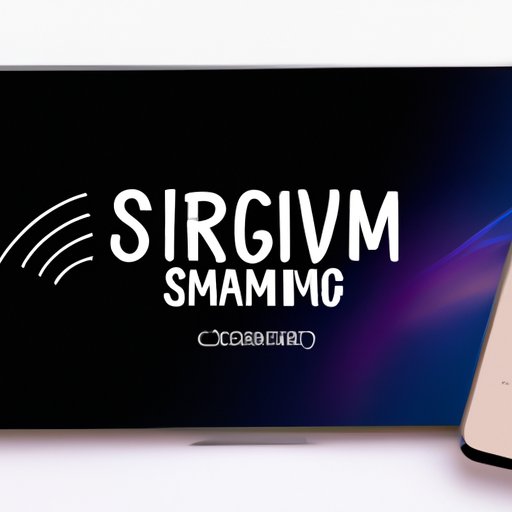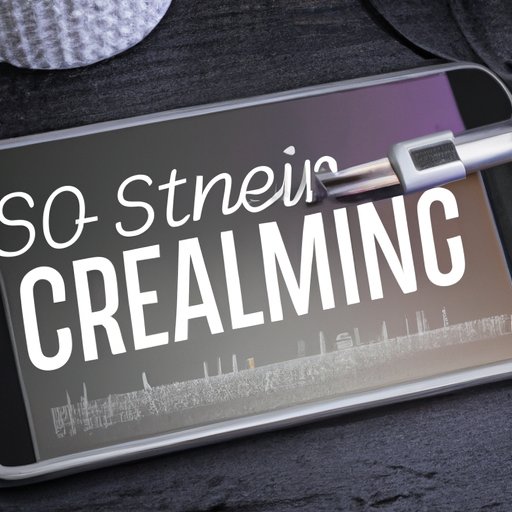
Introduction
Streaming from your phone to your TV is a convenient and easy way to enjoy your favorite video content from a bigger screen. With the right tools and methods, anyone can do it. This article aims to help beginners and those who have had trouble with this process in the past. By the end of this article, you will be equipped with the knowledge and skills to stream from phone to TV.
5 Easy Ways to Stream Your Phone to Your TV
There are various methods that you can use to stream video from your phone to your TV, but five of the most popular ones include:
- Apple AirPlay
- Chromecast
- HDMI cable connections
- VGA cable connections
- MHL cable connections
Each of these methods has its own advantages and disadvantages.
Apple Airplay
If you have an iPhone, iPad, or MacBook, AirPlay is the most straightforward option for streaming content from your phone to your TV. It works with Apple TV, Macs, and good speakers. By using a Wi-Fi network, you can display your video content on your TV.
Advantages:
- User-friendly interface with no extra apps necessary
- Compatible with iOS, MacOS, and Windows devices
- Provides high-definition video quality
Disadvantages:
- Can be expensive if purchasing an Apple TV device
- Not compatible with non-Apple devices
- Devices must be on the same Wi-Fi network for it to work efficiently
Google Chromecast
Chromecast, developed by Google, allows you to stream video content from both iOS and Android devices. You can connect your phone to your TV using a Wi-Fi network, and the Chromecast will allow you to stream content directly from your phone onto your TV screen.
Advantages:
- Budget-friendly option for streaming content
- Compatible with iOS and Android devices
- Easy setup and streaming process
Disadvantages:
- The video quality can be affected by a weak Wi-Fi signal
- Low-quality music streaming compared to other methods
- Does not allow direct connection to TVs that lack USB ports and HDMI connectivity
HDMI Cable Connections
The most well-known method of streaming content from your phone to your TV is by using an HDMI cable. By connecting your phone directly to your TV using an HDMI cable, you can enjoy high-quality video content from your phone on a bigger screen.
Advantages:
- Provides the highest resolution video quality
- Offers good compatibility with most devices
- Easy to purchase an HDMI cable from any electronics store
Disadvantages:
- The inconvenience of wires and cables
- The limited length of the HDMI cord, which can result in needing an extension cable or adapter
- Not as cost-effective as other options
VGA Cable Connections
The Video Graphics Array (VGA) cables allow you to transmit high-quality video signals from your phone to your TV. This option is commonly used in computer-to-projector connections for larger screens and is also an option for streaming content from your phone to the TV.
Advantages:
- Can be an affordable option for budget-conscious users
- Provides compatibility with VGA-enabled TV and computer devices
- Decent quality for the price
Disadvantages:
- The video quality is limited compared to other methods
- Only suitable for older TV sets and monitors with VGA ports
- Cannot transmit sound signal, requiring additional audio cables or adapters if you desire an audio output
MHL Cable Connections
The Mobile High-Definition Link (MHL) is an interface that allows you to transmit high-definition audio and video signals from your phone to your TV. This is a newer option for streaming to your TV, typically used for Android devices with MHL enabled ports.
Advantages:
- High-quality video and audio streaming
- Compatible with tablets and smartphones with MHL-enabled ports
- Does not require Wi-Fi connectivity
Disadvantages:
- Requires special cables or adapters that may cost more than standard HDMI cables
- Not compatible with all Android devices
- MHL-enabled ports may not be present in newer devices
Step-by-Step Guide: How to Stream Your Phone to Your TV
Once you have selected the option that suits your preferences and devices, you can then follow these simple steps to stream content to your TV from your phone:
1. Connect your phone and TV by pairing them either via Wi-Fi or cables.
2. Make sure your phone and TV are on the same Wi-Fi network or connected via cables.
3. If using Wi-Fi, ensure that both devices have sufficient signal strength and have connected properly.
4. To stream content from your phone to your TV using Apple AirPlay or Google Chromecast, open your desired video streaming app, select the content that you want to view on a larger screen, and click the Cast icon, which will resemble either the Chromecast or AirPlay icon, depending on which you are using.
5. If using HDMI, VGA, or MHL cable connections, input the correct output source on your TV, and the screen of your mobile device will be displayed on the TV’s screen. Then, open the desired streaming app and begin to enjoy your content.
Maximizing Your Streaming Experience: Tips for Connecting Your Phone to Your TV
Here are some additional tips to help you achieve a smoother and better streaming experience:
- Ensure that your devices are running on the latest software updates as it can improve the stability and performance of your streaming process.
- Invest in a Wi-Fi range extender, if your signal strength from your router is limiting your viewing capabilities
- Disable other applications running in the background of your phone for smoother streaming and better quality of content on the TV.
Be sure to troubleshoot and understand any potential connectivity issues that may arise, so that you can enjoy the best possible viewing experience.
Casting vs. Mirroring: Know the Difference!
There are two ways to stream content from a phone to TV- casting and mirroring. However, understanding when to use these methods can transform your streaming experience.
Screen casting allows your phone to act as a remote control while transmitting the content directly from the internet to the TV screen, which means your phone is free to do other tasks and not rely on an active connection throughout. When casting, your content will play on the TV at the same time as it would on the phone. Chromecast and AirPlay are examples of casting technology.
Screen mirroring, on the other hand, allows you to share your phone screen directly onto the bigger television screen. When you mirror, you can watch the same content from your phone but with the addition of your phone screen. This feature is designed for multi-tasking, such as presenting or for gaming or browsing the internet on TV. MHL, HDMI, and VGA are examples of screen mirroring technologies.
The Best Apps for Streaming from Phone to TV
Here are some of the best and most popular video streaming apps that you can use:
- Netflix
- Hulu
- YouTube
- Disney+
You can easily cast or mirror the video from any of these apps onto your TV. You can also check each app’s settings for additional options such as optimizing the video quality or managing data usage.

Wireless Streaming: How to Stream from Phone to TV Without HDMI Cables
If you don’t want to use an HDMI cable to stream your phone to your TV, you can use alternative methods like the Chromecast or Apple TV. You can also use wireless options like Google’s screen mirroring, which pairs your phone and TV using Wi-Fi network. Apple AirPlay is another option that uses Wi-Fi to transmit video and audio. Samsung’s Smart View is also an option which allows you to connect your phone to a Samsung smart TV.
However, keep in mind that wireless streaming may not be as seamless, which may result in buffering or lags in your video’s quality. Also be aware that some phones may be incompatible with certain wireless streaming options.
Troubleshooting Tips: What to Do When Streaming from Phone to TV Goes Wrong
If you encounter problems during the streaming process, it may be due to a bad Wi-Fi connection, an outdated software program, or lack of compatibility between your phone and TV. However, you can try the following tips before seeking professional help:
- Restart both your phone and TV to ensure that both devices are functioning well.
- Ensure both devices are connected to the same Wi-Fi network or connected with cables securely.
- Check that both devices run on the latest software updates.
- Remove other applications running in the background of your phone.
Conclusion
Streaming from your phone to your TV is a simple process with various methods available for you to choose from. As you experiment with different combinations of devices, cables and apps, you will learn about which setup works best for your needs. With this article as a guide, we hope you have a better idea of how to stream from phone to TV.
Remember, streaming can be an entertainment experience for all ages to enjoy, and finding the method that is most comfortable for you may take some experimentation to navigate. Start by following the steps we’ve outlined and soon enough, you will be streaming your favorite content on your TV like a pro.




